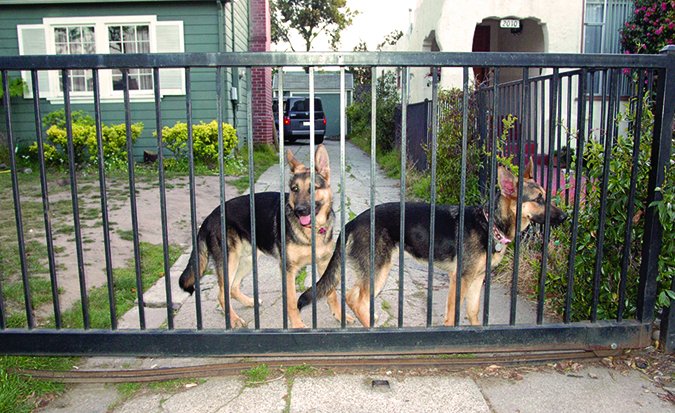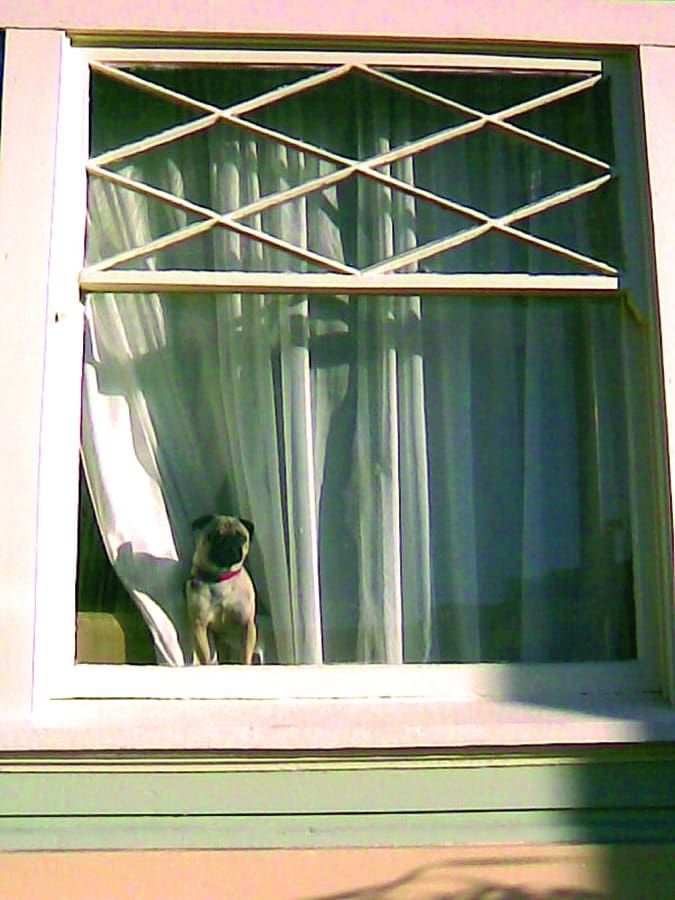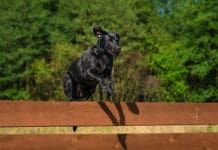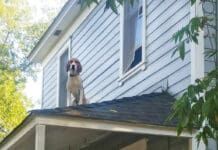DOG FENCING OPTIONS: OVERVIEW
1. Provide the best and safest fence you can afford for your canine family member.
2. Do not leave your dog in his fenced yard when you aren’t home. If you are home and inside while he is out, make it a point to be attentive to what he is doing, and bring him in at the first hint of trouble.
3. Make a vow to never use an underground shock fence for your dog.
There was a time when no one thought twice about letting their dogs roam the neighborhood. A fenced yard was almost unheard of. If you grew up in the 1950s and ’60s as I did, you may remember those times. Dogs were well socialized, loved kids, and it was no big deal when the neighbor’s dog came over and visited your female dog in season. Of course, they also chased cars, got pregnant a lot, and occasionally – although rarely – bit someone. You may also remember, as I do, a long list of childhood pets who got shot, hit by cars, or simply vanished, having fallen victim to who knows what fate.
Today, our canine companions are more likely to be spayed or neutered, vaccinated, and responsibly contained. As a result, they tend to live safer, longer lives. But having a fence isn’t always the be-all, end-all solution that it seems to be. Fences can bring on a host of challenges that our parents never faced with the family dog a generation ago.
The Best Dog Fence
One significant challenge is the cost of fencing. Unless you’ve purchased a house that already has a dog-proof fence around it, you’re looking at a significant investment of resources to install one. Whether you pay someone to do it or are a skilled do-it-yourselfer, you’re probably looking at least a few thousand dollars for a modest-sized suburban yard. The cost for materials for a six-foot chain link fence (not our favorite choice) for a 50-foot-square yard runs around two thousand dollars. Wood fencing, especially privacy fencing (the best choice, in our opinion), is considerably more.
If all you needed the fence for was to keep your dog from roaming, chain link would be fine. But you also need the fence to protect your dog from the unwanted attentions of passersby (human and otherwise) and to prevent him from becoming overly aroused by visual stimuli such as passing cars, bikes, joggers, skateboards, dogs, and mail-carriers.
When my husband and I bought our house in Chattanooga, Tennessee, it came with a lovely, large yard, fenced securely with chain link. Since our driveway was a quarter-mile long and passersby were rare, I thought we’d be fine.
However, a neighbor who lived a half-mile away had two Labrador Retrievers that he attempted to keep his on his property with an underground shock fence; we were treated to regular visits from the pair. I’m convinced that our Scottish Terrier’s dog-reactivity was initiated by (or at least significantly exacerbated by) his interactions through our chain-link fence with these two visitors. To this day, he is still most reactive to Labrador Retrievers and dogs who resemble that breed in body size, shape, and haircoat, although he has made a lot of progress with other types of dogs.

The Right Fence Height for Dogs
Regardless of the type of fencing you have or will have, it’s important that your fence fulfills its primary responsibility of keeping your dog contained. To that end, I recommend a six-foot high fence. Of course, not all dogs require a six-foot fence. Our fence at our current home in Maryland is only four feet high. It came with the house and none of our dogs are jumpers or climbers, so we can slide by with four feet for now. But if we were to adopt a dog who had high-jump proclivities, we’d be in deep trouble. If I were installing a new fence, it would be six feet, for sure.
Dogs escape from fenced yards because they can, and often because they’re left alone in them for long periods of time while owners are sleeping or away at work. They get bored and lonely and decide to go looking for something to do, or someone to be with. They employ a variety of escape techniques, including jumping or climbing over the fence, digging under, chewing through, or, in the case of the “non-fence” – running through. I try to avoid saying “never,” but I will say that I never leave my dogs in our fenced yard when I’m not home to keep at least half an eye on them.
If you have a dog who jumps your fence, raising the height in small increments is a great way to teach him to jump higher and higher – hence the benefit of installing a six-foot fence to start with, rather than starting at three or four feet and raising it gradually. If you have a super-athlete who can jump a six-foot fence, you can slow him down by planting bushes or placing something solid and heavy at his take-off point so he can’t gather himself properly to jump.
If your dog can climb a six-foot fence, you can install a “roof” that comes inward off the top of the fence at a 45- or 90-degree angle, so when he gets to the top he’s stymied. (This roof can also confound a jumper, who will have a harder time determining the fence height with the addition.) Or you can attach “coyote rollers” along the top of the fence – pieces of PVC pipe suspended on wires that will spin when he tries to grab the top of the fence to pull himself over. You can build these rollers yourself, or purchase them commercially.
Our dogs don’t jump our fence, but Dubhy, the Scottie, has managed to escape a few times, once by pushing out a loose board, and twice by squeezing through a gate that didn’t close tightly at the bottom. Our fence is old and one of these days we’ll have to replace it, but until then, we are diligent about checking for loose boards and faulty gates. In the meantime, we’re fortunate that we live smack in the middle of our 80-acre farm with a half-mile driveway, and that when Dubhy has escaped he hasn’t headed for parts unknown, but rather just explored the woods on our own property, and returned when we called for him. I suspect the first groundhog hole he finds keeps him happily and thoroughly occupied until he’s summoned home.
When we lived in Monterey, we had a Pomeranian who could squeeze under our privacy fence. A row of concrete blocks lining the inside of the fence stopped his efforts, but it wasn’t very attractive. If your dog is a digger, make a note to bury your fence at least six inches.
One last tip on keeping your dog contained: make sure there’s nothing next to the fence your dog can use as an escape aid. The top of a doghouse or a solidly stacked woodpile can make an excellent springboard; move them away from the fence. I have some incredible video footage of a small terrier who uses a tree trunk to support his rear legs as he climbs up a chain-link fence with his front paws, working his way up until he can jump over the top of the fence. Be sure to install your fence far enough away from any trees or other permanently fixed objects that could aid and abet your potential escapee.
Types of Fencing for Dogs: Avoid Potential Barrier Frustration
Dogs don’t limit themselves to escaping as their only fence-related means of complicating their humans’ lives. Dogs in fenced yards are capable of developing a host of undesirable behaviors such as barking, running the fence line, aggression toward dogs and humans on the other side of the fence, and redirecting aggression toward human and non-human family members on the inside of the fence.
Barking is usually boredom, alert/alarm, or arousal barking. Boredom barking tends to be a repetitive, continuous, monotonous, “bark-bark-bark” for hours on end, with little or no change of tone. These dogs are usually out the whole day while their humans are at work. Some are out 24 hours a day, seven days a week, bored and lonely. Boredom barkers are at the highest risk for being poisoned, shot, released, or stolen by a neighbor who is fed up with the noise. At best, the irritated neighbor might report the barking to a local animal control officer. The simple answer for these dogs is to bring them in and engage them in activities that stimulate them physically and mentally, so they are no longer bored and lonely.
Alert or alarm barking is the dog’s attempt to tell his humans that there’s something going on that he thinks they should know about. A dog who is frequently left alone in a fenced yard decides it’s his responsibility to be on sentry duty, and to let you know when something’s afoot. If he restricted his definition of “something’s afoot” to the bona fide burglar or approaching wildfire that would be fine. But he’s just as likely to include squirrels, cats, and the mail truck in his “afoot” category, and pester both you and your neighbors with his frequent pronouncements of neighborhood news.
A solid fence, as opposed to chain link, can reduce alarm barking, since the dog won’t see as much to bark at, but it won’t stop him from seeing tree-climbing squirrels or fence-walking cats, or his attention and response to auditory stimuli.
Arousal barking occurs when the dog has a strong emotional response to something in his sensory field. Again, it’s often a visual stimulus, but can also be auditory or even olfactory. Anything that involves a strong emotional response has the potential to become a serious behavior problem and often leads to aggression. The tone of this bark is serious – an intense, “Danger! Danger! Code Red!” kind of bark. The dog may also dash back and forth along the fence line, reaching a high state of arousal that continues long after the stimulus is out of sight. Arousal barking can generalize to anything on the other side of the fence – and woe to the unsuspecting child who reaches over the (four-foot) fence to pet the dog or feed him a cookie.
This dangerous level of arousal can be caused by passersby who tease the dog, but it can just as easily be caused by the constant frustration of wanting to greet the dog or person on the other side of the fence, but being unable to do so. In fact, the behavior, which quickly leads to aggression, is often called “barrier” or “restraint” frustration. The barrier doesn’t have to be physical to create this behavior; it can just as easily occur when the barrier is the threat of an invisible shock. The accumulated stress behavior, and the classical association that develops with the stimuli, can cause long-term behavior problems that require significant behavior modification (and a change of environment) to repair.
Redirected aggression is often related to barrier frustration. It happens when the target of a dog’s aggression is unattainable, while someone or something else is within reach. You may see it when two dogs who live together and know each other well are fence-running and becoming aroused at a dog or some other stimulus on the far side of the fence. Suddenly, one dog turns on his companion and a full-scale fight erupts. Yikes!
Outdoor Threats to Your Dog
We’ve already touched on some of the safety issues that can arise for your fenced-in dog, even when you’re confident he can’t escape the fence. Poisoning, shooting, accidental or deliberate release, and theft are just a few. Others include danger from wildlife. Coyote rollers can keep those rascally guys out as well as keep your dogs in, but the rollers don’t prevent contact with all wildlife. I’ve rescued five-foot black snakes from Dubhy. It makes me sad that he’s killed a couple before I could save them, but if they were rattlesnakes or copperheads the situation would be much more serious.
Rabid skunks, foxes, raccoons, and even bats can have contact with your furry friend when he’s out in that backyard on his own. I even met a young puppy once who had been lifted off his paws by a golden eagle who ultimately decided the potential meal was either too heavy, too squirmy, or both, and dropped him from a height of 20 feet. The puppy was lucky to be alive, and will bear a scar on his back from the eagle’s talons for the rest of his life.
Other potential backyard hazards include overheating, hypothermia, lightning strikes, alligators, brown recluse spiders, ingestion of poisonous mushrooms…Gee, I’m scaring myself. I think I’ll go call Dubhy in from my yard.
The answer to all these fence-related problems is to not leave dogs unattended in fenced yards. That includes not allowing free access to doggie doors when owners aren’t at home. A dog-walker is a better alternative if you must leave your dog home for periods much longer than eight hours at a stretch and no family members can dash home on lunch to let him out for a bathroom break.
When Is a Fence Not a Fence?
It sounds like a childhood riddle, but the answer to the serious question “When is a fence not a fence?” is “When it’s invisible.”
Even if the sole purpose of a fence was to keep your dog contained to a designated area, underground shock fences — commonly called “electronic containment systems” — do a
shoddy job at best. The two Labrador Retrievers that taunted Dubhy through our fence in Tennessee are not uncommon. Ask any animal control officer how many stray dogs end up in the shelter still wearing their shock-fence collars.
But containment of your dog is not the only reason for having a fence. If you’re still willing to shock your dog for a containment system that has a high failure rate, here are some more reasons not to use one:
1. It doesn’t protect your dog from intruders. Black snakes may slither through our wooden fence, but the rare stray dog who wanders by can’t get to my dogs. Strays can walk right across an invisible shock boundary with impunity. So can other animals, or human intruders who may have less-than-honorable intentions toward your dog.
2. It doesn’t protect others from your dog. Even if you have one of those dogs who never tests or runs through his fence boundary (and they certainly exist), it doesn’t stop well-
meaning people, including children who can’t read your fence warning signs, from crossing the boundary into his space.
3. The initial training, during which the dog must get shocked at least once, is supremely traumatic to some dogs. Stories abound of dogs who have refused to go into their yards after being shock-fence trained, and of those who developed housetraining issues because they were afraid to go outside at all. You don’t know until it’s too late if your dog will be one who is so strongly affected by the shock.
4. The dog can associate the shock with passersby and become increasingly aggressive when he perceives them as responsible for the shock. I have had clients, and almost every trainer I know has had clients, whose dogs had no problem with aggression toward humans until they put their dogs in an underground shock fence. Insidiously, many of these owners think it’s worth one “tiny” shock to be able to let their dogs run free in their unfenced yards — because after that one shock all they get is the warning beep. What they don’t understand is the dog associates the beep with the shock, so emotionally, hearing the beep is the same as being shocked.
5. And then…the shock fence beep is similar to many other electronic beeps. Digital watch beeps, microwave beeps, camera beeps, computer beeps, alarm beeps — and the dog can have the same emotional response to those beeps. I had a client last year whose rescue dog appeared to have separation anxiety — becoming destructive when left home alone. We ultimately determined that the anxiety-related destruction occurred when the dog heard a watch beeping in the kitchen drawer — the result of being conditioned to a fence/beep/shock in a prior home.
I know there are communities that don’t allow physical fences, and that underground shock fences are all the rage in those places. I wouldn’t live in one. If I did have to live somewhere with no fence, I’d use a leash, a long line, a super recall — but I wouldn’t use an underground shock fence. Not me. Not ever. Never.
Pat Miller, CBCC-KA, CPDT-KA, is Whole Dog Journal’s Training Editor. She is the author of The Power of Positive Dog Training; Positive Perspectives: Love Your Dog, Train Your Dog; Positive Perspectives II: Know Your Dog, Train Your Dog; and Play with Your Dog.







I will definitely install the best fencing for my dog. Great blog post thanks for sharing this type of posts.
It’s good to know that you should start with a high dog fence so that your dog doesn’t gradually learn to jump higher and higher over it. My dog often jumps up into my arms after I get home from work, and I want to get a fence so that I can let him out into the yard while I’m gone. I don’t want him to jump over the fence, so I’ll be sure to start with a tall one.
You are absolutely right.
The shock underground fences should not be permitted anywhere. I had one installed in the past and my dog was traumatized for years for using it only a short time by a “trainer” from the company selling them. I never used it after that event but my dog remenbered and didn’t want to go in the yard anymore.
My dog always escapes from our backyard. I like how you mention if your dog can jump a six-foot fence, you can slow him down by placing something solid and heavy so he can’t jump. Thank you for the advice. I’ll contact a fencing contractor to install a fence so our dog doesn’t escape anymore.
I like how you said to provide the best and safest fence you can afford for your canine family member. My sister has a large dog and she just moved to a bigger house that has a very nice and open front yard. I will recommend her to install an aluminum fence so that she can let the dog free.
You make a good point when you say that we should keep in mind what hight would be adequate for our dogs. I just moved into a new house and I want to install a fence so that my dogs can play in the front yard and be safe at the same time. They are big dogs and love to jump over things so a 6-foot fence would be perfect for them.
Thank you for helping me to understand that a fence can reduce the amount of alarm barking that a dog does. My dog barks a lot even when there is nothing around, and I can’t seem to get him to stop. It seems like it would be a good idea to change my fence to a solid kind and see if that helps.
I like what you said about getting a taller fence if your dog like to jump. My sister has been telling me about how she and her husband would like to adopt a dog in the coming weeks. I’ll share this information with her so that she can look into her options for getting the right fence for the dog they choose.
I like what you said about getting a fence installed so that your dog doesn’t face any safety issues. My brother has been telling me about how he wants to make sure that his dog is as safe as possible in the coming months. I’ll share this information with him so that he can look into his options for professionals who can help him with this in the future.
I moved to a home on a quarter-acre property with my spouse and elderly dog ~2 years ago. The home was missing privacy fencing on one side and was instead bordered by 7′ chain-link fencing. Naturally, that was the side where a neighbor had a German Shepherd that refused to “agree” that we belonged on our side of the fence.
Our initial plan was to plant a box hedge or similar on our side but the presence of tree roots along the fence line prevented us from adding the landscaping privacy we wanted. (We even paid a tree service to come in and grind out tree stumps and roots along our entire property line but they decided to take advantage of the new folks in town and skip out on the tree root removal.) As a result, we’re forced now to consider a Plan B: privacy slats. Yes, a dog would be able to see through the slats as it neared the fence line — but it would likely solve a good chunk of the problem.
Chain link is said to be a bad choice for dogs that climb — but that risk could presumably also be reduced by the addition of privacy slats (a dog that can’t see the “greener grass” on the other side may have less incentive to climb over). Vinyl fencing is said to be a bad choice for dogs that are strong enough to break through (such as pit bulls). Wood fencing is higher maintenance and takes a beating in many climates. Chain link isn’t the most aesthetic choice but it’s also within the realm of a DIY homeowner. In addition, I read elsewhere online that if one digs a trough along the bottom of the fence and attaches chicken wire just below the soil line, it is even possible to discourage digging (dog hits chicken wire in the event it attempts to dig under the fence). All in all I think chain link can be made to work for many dogs — providing the privacy slats are also installed and the height is adequate. Having said that, it always pays to check your HOA rules or City code requirements. There may be height and design limitations on what kind of fencing can be used.
Thanks for the tip to make sure there are no objects near the fence that our dog could jump on top of and escape. My husband and I want to have a chain-link fence installed around our front yard so we can let our new dog out to the bathroom without worry of him running off. Using your tips will give us additional peace of mind that he’ll be safe and secure in the yard!
please help i have three dogs and no fence i am seeking a program that i can pay cheap amount monthly to build me a fence around the front area very small area i am a senior and in bad area .but needing help no longer can walk good cannot chase them please help on fix income and willing to pay monthly please one of my dogs was killed because of being tied up please help love my dogs they are my protection and my company when no one else can make me move they do please help 2045.n.lasalle.st 46218.317 939 7193 indianapolis indiana marion … yvette hardney